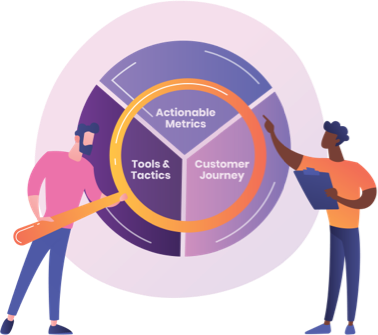Avoid data-blindness and gain cross-functional alignment with a Growth Scorecard

One of the key factors to our client success is that we formalize the way we gather, review, analyze and act on information. And one of the ways we do this is a shared Growth Scorecard*.This scorecard shows:
- Key performance indicators (KPIs) for each stage of the customer journey
- Goals for each KPI
- Weekly results and status data
This information makes it easier to identify, at an organizational level, where in the Customer Value Journey* a company is doing well and where it is losing traction. Regular reviews across cross-functional teams helps us to spot trends and optimize campaign creative, budgets and tactics. The Growth Scorecard serves as a sales and marketing alignment tool, and also as a status and accountability report at an executive or leadership level.
What does a Growth Scorecard look like?
Below is an example of a Growth Scorecard. You’ll see that the format and output are simple, using the eight distinct stages of the Customer Value Journey as the foundation.
Each stage will have dedicated marketing KPIs or metrics, and each metric will be assigned a goal to measure success. Goals should be based on past data or industry standards and are not limited by platform. Here is an example of a scorecard showing KPIs by stage.

How do we decide on KPIs? Where do we get the data? Can this be automated?
We have three general rules when it comes to selecting KPIs for the scorecard.
- Use actionable metrics only – metrics you can track and take action on week over week. Vanity metrics won’t work. You are looking for data values or trends that will trigger a decision. If it takes longer than a weeks or months to spot trends, or if you only have access to data on a monthly or quarterly basis it’s not a good candidate for the scorecard.
- Limit yourself to three (3) KPIs per stage of the Customer Value Journey. The scorecard represents the distilled version of your metric universe, designed to support making decisions that will keep you and your teams on target week to week.
- Make sure your data is easy to access and report. If it takes days to produce or compile the data for a weekly scorecard, it runs the risk of being perceived as an undue burden and not getting done. That doesn’t mean it doesn’t belong on the scorecard. It just doesn’t belong there now.
One of the features of the Growth Scorecard is its relative simplicity. It can be created, tested, and adopted quickly without the need for large scale investments in resources and technology. As for automating the production of the Growth Scorecard, we advise testing before scaling.
Why should I have a Growth Scorecard? How is this better than what I have now?
Senior marketing and business leaders are inundated with data and reports. A 2019 study by Domo and Censuswide found that:
- The vast majority (80 percent) of enterprise marketers say that the industry is focusing on too many metrics.
- And a larger percent (86) say that long-term planning has become more difficult due to the number of data channels and sources.
By focusing on a handful of the most important, actionable metrics across the Customer Value Journey, the Growth Scorecard avoids the data blindness that comes with channel- and source-specific reporting. If it’s not directly and quantifiably contributing to the metrics driving growth then perhaps you shouldn’t be using it. If it is, then most likely the high level KPIs that are essential to the Growth Scorecard are readily available.
Even when succinct reporting data is available, it is often too infrequent and siloed to be actionable. Imagine you contract with vendors for paid media, paid search, and SEO, and utilize internal resources for lead and sales nurturing functions. At regular intervals you may receive reports and analysis from each describing their campaign-specific results. By themselves, the reports may provide insight into the performance and contribution of a particular vendor, discipline, and campaign. But the growth of the business requires that all are working in sync. The Growth Scorecard is designed to help avoid these pitfalls. Clearly defining actionable metrics across the full Customer Value Journey and reviewing them weekly with your cross-functional teams (including sales, support, vendors) aligns all parties towards the end goals and encourages an open discussion about overall growth versus individual success.
Interested in creating your Growth Scorecard?
Request a free consultation by completing the form below.
*As a trained and licensed DigitalMarketer Certified Partner, we use the DigitalMarketer framework, which includes the Customer Value Journey, Customer Avatar Canvas, the Growth Scorecard and other tools and resources.